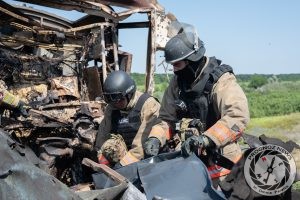The Russian Military Formation Rubikon

By Matthew Parish, Associate Editor
Amongst the many experimental and improvised formations that have emerged from the Russian war effort in Ukraine, few have attracted as much attention as the so-called Rubikon unit, formally the Centre for Advanced Unmanned Technologies. Although it presents itself as a research, training and development centre, Rubikon has evolved into a hybridised combat organisation that combines the attributes of a military school, an elite drone battalion, a testing ground for new technologies, and a propaganda showcase for the Kremlin. It is one of the clearest indicators of the Russian Federation’s shift towards an unmanned-systems-centred model of warfare. We consider Rubikon’s origins, internal structure, tactics, equipment and strategic role, drawing together the available public material into a single expanded analysis.
Origins and the purpose of the formation
Rubikon appears to have been created in mid-2024 under the personal direction of Andrei Belousov, at that time the Russian Defence Minister. The name, evoking Caesar’s decisive crossing, suggests a turning point: a recognition that Russia’s war had moved beyond the era of mass infantry waves and artillery duels and into a domain in which technological advantages could be decisive. Unmanned systems offered a means of compensating for manpower shortages, replenishing attrition at lower cost, and matching or surpassing Ukraine’s early technological innovation in FPV drones and autonomous strike systems.
Although nominally established as a research and development institute, Rubikon has always had a combat mandate. From its inception, the centre was expected not merely to test devices but to deploy them directly, shortening the distance between prototype and battlefield. This reflects a profound change in Russian military culture: a willingness to allow rapid technological iteration and operational experimentation, in contrast to the traditionally rigid Soviet inheritance.
Structure, personnel and internal culture
Rubikon’s structure can be described as a fusion of academy, engineering bureau and specialist light-infantry drone detachment. Its principal components include:
-
A training school for reconnaissance pilots, FPV operators, maintenance technicians and electronic warfare specialists. Training cycles are reported to last approximately six weeks, although some operators undergo more intensive instruction.
-
A development and engineering wing that draws on a wide variety of inputs, including small private engineering collectives, volunteer designers, university laboratories and semi-formal networks within Russia’s improvised drone industry. Rubikon thus acts as a node linking fragmented innovation spaces to the Russian armed forces.
-
Operational drone detachments capable of deployment as semi-autonomous cells along multiple axes. These detachments integrate reconnaissance, FPV strike platforms, EW assets and mine-laying drones, and they often operate supporting Russian infantry or deep behind Ukrainian lines.
-
A staff body responsible for collecting operational data, synthesising battlefield lessons and feeding them directly back into new designs or modified tactics.
Rubikon’s internal culture departs sharply from the rigid hierarchy typical of the Russian military. Its operators enjoy unusual tactical latitude. They are encouraged to experiment, to adapt doctrine to terrain, and to leverage their technological edge to shape engagements. This ethos is reminiscent of Western special forces models and contrasts with the wider Russian military’s tradition of authoritarian command.
Equipment and technical innovation
Rubikon fields a diverse and sophisticated set of unmanned systems that reflect Russia’s determination to regain the initiative in drone warfare. These include:
-
FPV drones equipped with high-yield munitions, used to destroy transport vehicles, Ukrainian drone teams, ammunition trailers and isolated infantry. The unit is known for heavy FPV designs capable of carrying larger explosive charges than typical Ukrainian counterparts.
-
Fibre-optic tethered drones, which circumvent Ukrainian electronic-warfare systems by operating without radio links. These have proved difficult to neutralise, as jamming is ineffective against a physical tether.
-
Reconnaissance drones of various classes, enabling persistent observation of Ukrainian defensive positions, movement corridors and supply nodes.
-
Remote-mining drones deployed to lay anti-personnel or anti-vehicle charges along forest roads, bridges and rural routes.
-
Maritime and sub-surface drones in experimental phases, signalling an ambition to expand unmanned warfare beyond the land domain.
-
Organic EW systems, including elements of the Shtora complex, capable of suppressing Ukrainian quadcopters, degrading video transmission and masking Russian movements.
In combining reconnaissance, strike and EW within a single formation, Rubikon does not merely operate drones: it shapes the electromagnetic environment, the tactical sight picture and the tempo of engagements.
Tactical doctrine and battlefield methods
Rubikon’s doctrine emphasises flexibility, precision and depth of reach. Rather than functioning as a conventional frontline unit, its detachments operate as mobile drone strike groups with several key mission types:
-
Interdiction of supply routes, striking logistics convoys, fuel lorries and ammunition shipments.
-
Systematic hunting of Ukrainian drone teams. This involves identifying control stations, antennas, vehicle signatures and operator positions and then launching FPV strikes upon them.
-
Persistent reconnaissance, providing real-time battlefield intelligence that regular Russian units often lack.
-
Remote mining operations intended to slow Ukrainian advances, complicate resupply efforts and increase attrition.
-
Coordination with Russian artillery and ground forces, using drone feeds to adjust fire and integrate attacks across domains.
Rubikon’s tactical approach reflects a wider Russian shift in which drones increasingly dictate the rhythm of combat, while traditional forces provide the supporting framework.
Operational history, battlefield influence and limitations
Rubikon emerged prominently during Russia’s operations near Kursk and Sudzha, where its deep interdiction missions hindered Ukrainian movements and facilitated Russian counter-attacks. On the Kupiansk axis the unit has demonstrated the utility of fibre-optic drones, which Ukrainian electronic warfare systems initially struggled to counter. Ukrainian accounts confirm Rubikon’s presence in these theatres and acknowledge the challenge posed by its mixed reconnaissance-and-strike model.
However Rubikon faces structural limitations. Terrain can considerably reduce drone efficiency, particularly in dense forestry, urban zones and hilly areas. The Russian logistics apparatus remains strained, and technical losses are high. Ukraine is also adapting. Western-supplied jammers, counter-UAV guns, mobile EW teams and laser-based defence systems have reduced the freedom with which Rubikon can operate on certain sectors. Although its tactical successes are genuine, they do not in themselves guarantee strategic advantage.
Strategic and geopolitical significance
Rubikon’s significance extends beyond its immediate battlefield effects. In strategic terms, it reflects Russia’s attempt to shift decisively into unmanned-system dominance, mirroring Ukraine’s pioneering efforts in 2022–23. It also suggests a new model of procurement and experimentation in the Russian armed forces: decentralised, rapid, and directly responsive to battlefield needs. Politically, the unit serves as a propaganda showcase, demonstrating to domestic audiences that Russia remains technologically competitive.
Internationally, Rubikon poses a challenge to Ukraine and her supporters. Western and Ukrainian planners must respond not only to the unit’s tactical innovations but to the broader Russian move towards an unmanned-led military doctrine. Failure to counter Rubikon’s methods risks ceding the technological initiative.
Comparative assessment: Rubikon and Ukraine’s leading unmanned formations
A full understanding of Rubikon requires assessment against Ukraine’s own top-tier unmanned units, which have shaped the course of the war even more profoundly than Russia’s formations.
Ukraine’s Unmanned Systems Forces, formally established as a new military branch in 2024–25, represent a national-scale institutionalisation of drone warfare. Unlike Rubikon, which remains a single elite formation, the Ukrainian branch coordinates production, doctrine, training and field employment across multiple brigades. Ukraine’s approach is thus broader, more decentralised, more systematised and more deeply integrated into national mobilisation structures.
Alongside this branch, Ukraine’s specialist units have achieved high tactical sophistication. The Achilles battalion within the 92nd Mechanised Brigade is amongst the most renowned, operating as a precision-strike FPV unit with an extraordinary record of armoured kills, counter-battery strikes and targeted eliminations of Russian positions. Achilles integrates its own research-and-development capacity, but unlike Rubikon it is fundamentally a frontline assault and reconnaissance unit rather than a research centre with operational detachments.
Ukraine’s Army of Drones initiative has further expanded capabilities by linking civil society, technical volunteers, private firms and military operators. In contrast to Rubikon’s closed and ministerially directed structure, the Ukrainian model is decentralised, open and adaptive. Crowdfunded innovation allows rapid fielding of novel types, including long-range heavy FPVs, autonomous recon cross-country drones and jet-powered suicide drones.
Where Rubikon has an edge is in the durability of its EW infrastructure and its access to centralised state resources, allowing for expensive experiments such as fibre-optic drones and integrated Shtora modules. Ukrainian units often rely upon more commercially derived systems, albeit modified with exceptional ingenuity. Conversely, Ukraine maintains a superior operator culture: its best FPV pilots can engage multiple targets with unmatched precision, and its tactical creativity often outpaces that of Russian units.
Rubikon is Russia’s attempt to replicate, concentrate and professionalise capabilities that Ukraine has pioneered at scale. Ukraine’s advantage remains in the breadth of her unmanned vehicle system and the quality of her operators; Russia’s advantage lies in state-backed consolidation, allowing for standardisation and sustained production.
Outlook
Rubikon’s long-term relevance will depend on whether its experimental ethos can survive within the wider Russian system and on the pace of Ukrainian counter-drone innovation. The next phase of the war is likely to be dominated by attempts to break drone stalemates through directed-energy weapons, improved EW, autonomous targeting and mass-production of cheap but precise FPV units. Rubikon will continue to push Russian capabilities forward, but Ukraine’s broad-based innovation culture gives her a strategic advantage that should not be underestimated.
The Rubikon formation represents a significant evolution in Russia’s conduct of the war in Ukraine. It embodies a shift from traditional attritional methods towards integrated, technology-driven operations. While Rubikon has achieved measurable tactical successes and demonstrates genuine innovation, it operates within a military system whose structural constraints limit its strategic impact. The Ukrainian armed forces, by contrast, have developed a more comprehensive drone network that remains the global benchmark for battlefield innovation. As the war enters its next phase, the contest between Rubikon’s model of centralised experimental capability and Ukraine’s decentralised, civil-military innovation network will shape the future of unmanned warfare in Europe.
11 Views








